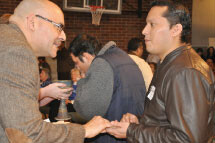
Hispanic plan takes root in BWC
 BY MELISSA LAUBER
BY MELISSA LAUBER
UMCONNECTION STAFF
Una iglesia – one church – that speaks both English and Spanish, with a hundred different accents – that’s the goal of the Hispanic Plan that is being lived out in the Baltimore-Washington Conference.
"If the Kingdom of God is not segregated, why on earth is the church?" asked the Rev. Edgardo Rivera, the conference staff person for Hispanic Ministries.
A church should reflect the community around it, Rivera said. In the Washington, D.C., region, Latinos make up 8.3 percent of the population. In Maryland, Latinos comprise 7 percent of the population; but in some regions, like Montgomery County, 15 percent of the residents are Hispanic. Those
numbers are predicted to nearly triple by 2050. In this area, in 2050, one in three people are expected to be Hispanic, Rivera said. "But in our churches in the Northeastern Jurisdiction, Hispanics make up only .56 percent of The United Methodist Church.
"We worship a God with a bigger vision than that," said Rivera.
However, after much theological and strategic thought and planning, the conference is opting not to create distinct Hispanic congregations that segregate communities by culture. Nor are they encouraging a landlord-tenant model, of one community renting space from another.
"One church is our goal," Rivera said. "Such unity becomes a living demonstration to the world of the Gospel power to transform lives."
Toward this end, the Camino de Vida congregation was recently merged with the congregation at Epworth UMC in Gaithersburg. Separate worship services are offered in English and Spanish but the church shares a facility, resources, leadership and a monthly Communion service.
Hughes UMC in Wheaton and Millian Memorial UMC in Rockville are also creating strong Latino ministries.
The denomination recently trained 30 Latino lay people to plant new faith communities during a 10-week program at Wesley Theological Seminary. The participants, about half from the Baltimore-Washington Conference and half from the Virginia Annual Conference, were the first to be trained in the denomination's new Lay Missionary Planting Network.
The students, who graduated in December, are the pioneers in a denominationwide program, called Path 1, whose goal is to plant 650 new churches by 2012.
Approximately 34 percent of the Hispanic population in the United States is unchurched, said the Rev. Sam Rodriguez, director of Hispanic/Latino New Church Starts for Path 1.
The laity in the Network, who are all volunteers, were equipped to begin a small group that will become a worshipping community. They will lead and nurture that group, helping it grow to the point where the group members may wish to become associated with an existing congregation, Rodriguez explained.
Each of the lay planters is asked to be entrepreneurial as they discover how to live out this calling of creating new faith communities. "We don't know what exactly to expect," Rodriguez said. "We want them to be out of the box in the ways they do things. Right now we don't know how things will play out. But the church is willing to take this risk."
The Rev. Daniel Mejia of Emmanuel UMC in Beltsville, was recently featured on the Latino ministries training DVD, "Pentecost Journey."
"Reaching out to the Hispanic community is as simple as offering hospitality," he said. "The Hispanic community is exploding. This is our opportunity to bring the love of Christ." Like Pentecost, this moment "is like the Spirit of God coming to life in the church to remind us that we are not in control of the word of God. …We need to not limit that work, but be open to the Spirit."
Steps for starting a multicultural church
Any church can reach out to the Latino community in meaningful ways. But recent history has shown that there are best practices in developing a multi-ethnic church, said Rivera.
"The biggest mistake churches make is to just jump in and do things prematurely," he said.
There are three proven stages: see, judge and act. None should be skipped and mediocrity should be avoided at all costs.
The first stage, "see," involves preparing the non-Latino congregants. This can take up to a year, Rivera said.
Create a core team that can analyze and identify the needs of the Latino community, doing careful evaluations of what's most important and devising a detailed plan, encouraging conversation and creating buy-in from the entire church. Everyone should be aware of the goals and expectations. If people are not ready, wait, Rivera said.
Stage 2 is doing outreach based on needs. Develop one or two ministries and do them with excellence.
Some churches start with English as a Second Language program. Others offer programs for children, festivals, health fairs or assistance with immigration issues. From this outreach, invite people to join a faith community. When critical mass is reached, with 40 adults or more, consider starting a worship service.
"The mission field will determine the methods a church uses," Rivera stressed.
The third stage is evaluation, which should be honest and ongoing. "Some people will be uncomfortable, but they're often willing to step out of their comfort zone when they see the fruits of new music or ministry, or ways of being the church," Rivera said.
"The goal is one church. Create expectations and see what comes from there. We have a long way to go in creating multicultural churches, but we are on the journey," he said.

Login/Register to leave comment